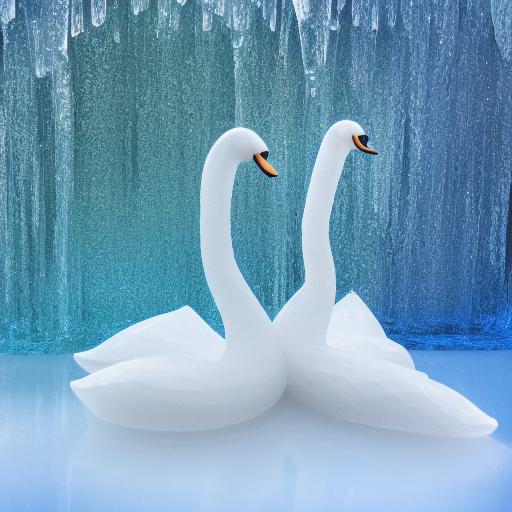How to write this prompt?
Here’s a breakdown of the different elements of the prompt and how they influence the image being generated:
- Description of the object: “an tranquil ice sculpture”
- This sets the stage for the image by establishing that it will feature an ice sculpture as its main subject.
- Description of the ice sculpture: “of two sparkling ice-made swans on a wave”
- This specifies the details of the ice sculpture, including the fact that it features two swans on a wave. This gives the AI a clear idea of what the subject of the image should look like.
- Information about the artist: “an ice sculpture by Susan Heidi”
- Including the name of the artist can help inspire the AI to create an image that fits with the style or aesthetic of that artist.
- Artistic style: “art deco“
- This provides further information about the type of image that is desired. In this case, the prompt specifies an Art Deco style, which the AI can use as a basis for creating the image.
- Specifics about the subject matter: “swan, wings of a swan”
- These details further inform the AI about the subject of the image and can help it to create a more accurate representation of the swans and their wings.
- Contextual information: “in a party”
- This adds context to the image by specifying that the ice sculpture is located in a party setting. This can inspire the AI to create a more dynamic or celebratory image.
- Reference to image source: “pixabay“
- Including a reference to the image source can help the AI to better understand what is expected of it and what type of image it should be creating.
By including all of these elements in the prompt, the AI is given a clear idea of what the final image should look like, including the subject, style, context, and other important details. This helps to ensure that the generated image meets the expectations of the person who wrote the prompt.
What is the history of ice sculpture art?
Ice sculpting has been around for thousands of years, with evidence of ice sculptures dating back to ancient China and Persia. However, it wasn’t until the 19th century that ice sculpting began to be recognized as an art form, particularly in Europe. Today, ice sculpting is a popular form of artistic expression around the world, with competitions and exhibitions showcasing the talents of ice sculptors.
How to make an ice sculpture?
Making an ice sculpture requires a lot of skill and specialized equipment. The basic process involves creating a large block of ice, usually by freezing water in a mold. The ice block is then shaped and carved using various tools and techniques, such as chisels, chainsaws, and blowtorches. Many ice sculptors also use special lighting to enhance the appearance of their creations.
Why is the swan a popular subject for ice sculptures?
The swan is a popular subject for ice sculptures because it is a graceful and elegant animal that is often associated with beauty and romance. Additionally, the curved lines of the swan’s body and wings lend themselves well to the medium of ice, allowing sculptors to create intricate and detailed sculptures that capture the natural beauty of the swan.
Can AI art generation prompts be used for educational purposes?
Yes, AI art generation prompts can be used for educational purposes in a variety of ways. Here are a few examples:
- Art history: AI-generated art can be used to teach students about the history of different artistic movements and styles. By generating art in the style of different artists, students can gain a deeper understanding of the characteristics and techniques associated with those movements.
- Creative writing: AI-generated art can be used as a starting point for creative writing exercises. Students can look at the generated art and use it as inspiration for short stories, poems, or other forms of creative writing.
- STEM education: AI-generated art can be used to teach students about computer science and machine learning. By exploring how AI algorithms generate art, students can learn about the underlying principles of machine learning and gain a deeper understanding of how computers process information.
How can AI-generated art be used to inspire or inform other forms of creative expression?
AI-generated art can be used to inspire or inform other forms of creative expression in a variety of ways. Here are a few examples:
- Music: AI-generated art can be used as inspiration for creating music. By analyzing the shapes, colors, and textures of the generated art, musicians can create soundscapes that capture the mood and atmosphere of the art.
- Fashion: AI-generated art can be used as inspiration for fashion design. By analyzing the shapes, patterns, and colors of the generated art, fashion designers can create clothing that reflects the same aesthetic.
- Film and video: AI-generated art can be used as a starting point for creating animations or special effects. By using the generated art as a basis for their designs, filmmakers and video artists can create visually stunning and unique works of art.
Visualize your ideas like never before with the power of AI-generated art and design tools from Visual Paradigm Online. Elevate your designs to the next level by effortlessly integrating stunning graphics with just a few clicks. With a user-friendly interface and a vast selection of design templates and assets at your disposal, you can explore and experiment with various styles and layouts until you create the perfect masterpiece. Discover the limitless potential of AI-generated art and transform your creative vision into reality with Visual Paradigm Online.


